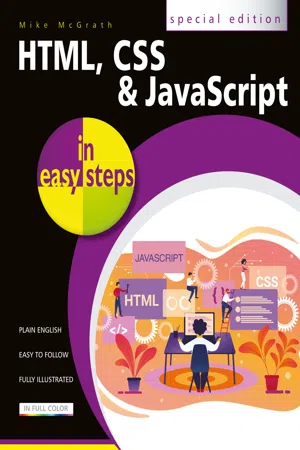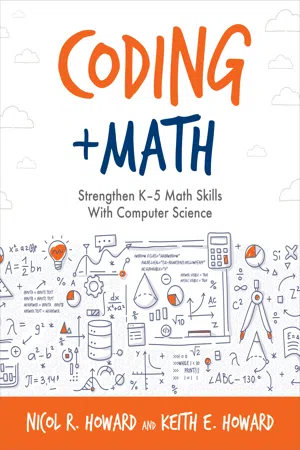Javascript If Statement
The JavaScript if statement is a conditional statement that executes a block of code if a specified condition is true. It allows for the creation of decision-making processes in a program, enabling different actions to be taken based on different conditions. This fundamental programming construct is essential for controlling the flow of a program based on specific criteria.
4 Key excerpts on "Javascript If Statement"
- eBook - ePub
Confident Web Design
Master the Fundamentals of Website Creation and Supercharge Your Career
- Kenny Wood(Author)
- 2018(Publication Date)
- Kogan Page(Publisher)
...Well, we can make use of them in conditional statements. What’s a conditional statement? It’s only one of the most important aspects of all programming languages … Conditional statements Conditional statements allow us to write code that gets executed when certain conditions are met. They enable us to write code that reacts and responds to changes and is dynamic in nature. We are able to do this through the use of four different conditional statements. This is another area of JavaScript where it’s much easier to see it in action, rather than explain. So let’s jump straight in with an example of an if statement. The if statement If statements are quite literally a block of code that will run if a statement is true. The syntax is nice and succinct, and very descriptive. if(1 < 5) { console.log(‘Condition is true’); } Looking at the above code it is fairly self-explanatory. The statement outlines that if 1 is less than 5, then the code inside the block should run, and log ‘Condition is true’ to the console. This is as complex as standard if statements get. They simply run if the statement inside the parenthesis returns true. If statements will only run the block of code once, unlike a loop, which will run it a number of times. To write an if statement, you simply write the keyword ‘if’ (this keyword is case sensitive, so always lowercase ‘if’ as using uppercase will throw an error) followed by parenthesis. Inside the parentheses you can write just about anything you like and pass in any variables from outside of the statement if you wish. The only clause is that if you don’t write a condition that can’t be validated to true, the block of code will never run. After the parenthesis, and our condition, we write our code to be executed inside the curly braces. This code can be anything again, and can use the variables that were pulled in, global, or created inside the parenthesis...
- eBook - ePub
- Mike McGrath(Author)
- 2020(Publication Date)
- In Easy Steps Limited(Publisher)
...17 Manage the Script Flow This chapter describes the JavaScript control structures and demonstrates how they control the progress of scripts. Branch If Branch Alternatives Switch Alternatives Loop For Loop While Do Loops Break Out Catch Errors Summary Branch If The progress of any script or computer program depends upon the evaluation of conditions to determine the direction of flow. Each evaluation may present one or more branches along which to continue according to the result of the evaluation. In JavaScript, the basic conditional test is performed with the if keyword to test a condition for a Boolean true or false value. When the result is true, a statement following the evaluation will be executed, otherwise this is skipped and flow continues at the next subsequent statement. The syntax of an if statement demands that the condition to be tested is placed within parentheses after the if keyword, and looks like this: if (condition) execute-this-statement-when-true An if statement may also specify multiple statements to be executed when the result is true by enclosing those statements within braces, like this: if (condition) { execute-this-statement-when-true execute-this-statement-when-true execute-this-statement-when-true } The evaluation of a condition and the execution of actions according to its result simply reflects the real-life thought process – for example, the actions you might execute on a summer day: let temperature = readThermometer () const tolerable = 25 if (temperature > tolerable) { turn_on_air-conditioning () get_a_cool_drink () stay_in_shade () } The conditional test is...
- eBook - ePub
Coding + Math
Strengthen K–5 Math Skills With Computer Science
- Nicol R. Howard(Author)
- 2020(Publication Date)
...Example one is the simplest of the if statements, and it would only run the code between the curly braces if the condition evaluated to true; otherwise, the program would just continue to the next code below it. Example two runs the code below the if statement if the condition is true, but runs the code below the else statement if the condition is false. In example three, if condition one is true, the program will run the code under the if statement; if not, it will test for condition two, and if true, it will run the code under the else-if statement. If neither condition one nor condition two are true, it will run the code under else. Note that one and only one of the code blocks will be executed. Finally, example four adds multiple else-if statements and operates the same way as the previous example, as only one of the four code blocks will be executed. You can string together as many else-if statements as you like, each with its own condition. Learning how to use these statements, particularly in the context of programming toward a particular outcome, goes a long way in developing students’ ability to sequence and to apply logic to scenarios with predictable outcome options. Math learning is strengthened when the Boolean statements used in the conditions are based upon mathematical equations being evaluated as true or false. With this approach, the math is no longer arbitrary (as it may sometimes seem in common math exercises), but is essential to achieving a specific programming goal. Given the accepted and expected process of debugging that is part of the programming culture, learners can test their answers by running their program without any evaluation-based affect involved...
- George Pruitt, John R. Hill(Authors)
- 2012(Publication Date)
- Wiley(Publisher)
...But, remember back in Chapter 1 when we discussed the precedence of operators and how parentheses can change their order. In this example, we have True and (False or True), which reduces down to True and True. We first evaluate the information inside the parentheses and then do the next comparison. Inside the parentheses, we have False or True, which is True. We then compare True and True; and as we all know, this is True. The if-then statement is the simplest form of conditional branching. This statement causes the program to execute a single statement or a block of code if a condition is True. When the compiler first encounters an if-then statement, it evaluates the information that is provided by the conditional statement. The evaluation produces one of two possible results—True or False. If the statement is True, the line or block of code immediately following the if-then is executed. If the result is false, the program skips the line or block entirely. The if-then construct has the following syntax (syntax is the body of rules governing which statements and combinations of statements in a programming language will be acceptable to a compiler for that language): if(conditional statement) then [single statement]; if(conditional statement) then begin [multiple statements] end; You must always include the word “then” after the if conditional statement. The parentheses around the conditional statement(s) are optional, but they do help in clarification. If you want more than one statement to be executed after a conditional branch, you must use the words “begin” and “end.” “Begin” marks the beginning point of the block of code, and “end” literally marks the end of the block of code...



